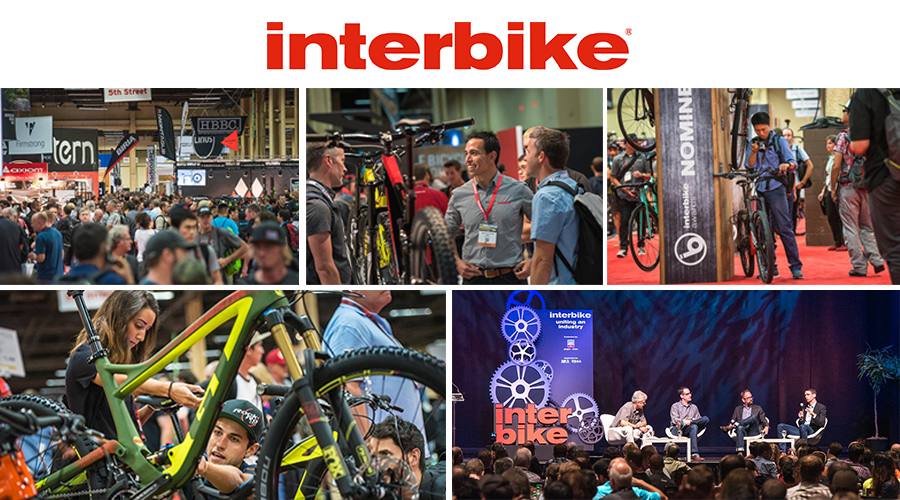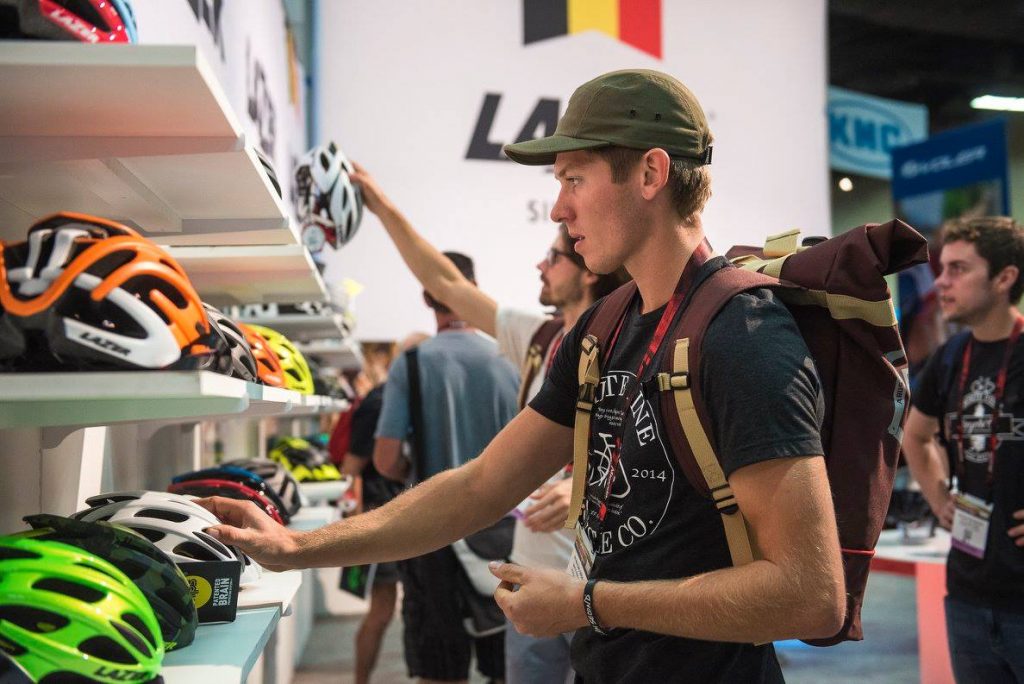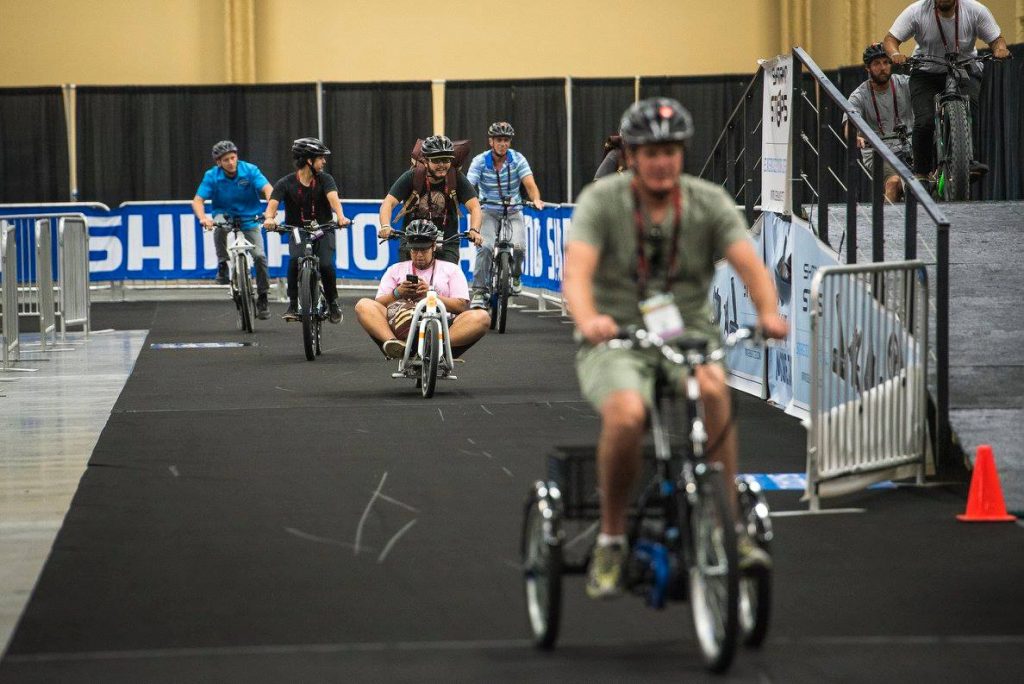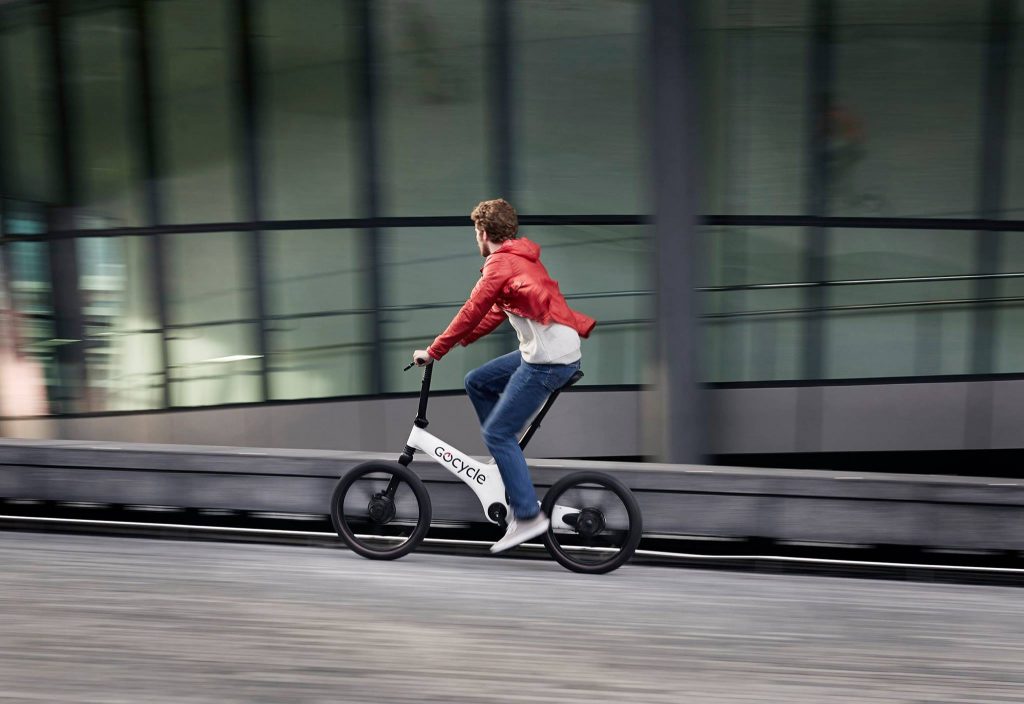By Charlie Lunan
Bike geeks feasted on a more than 300,000-square-foot smorgasbord of fatter tires, smarter helmets, sleeker e-bikes and products to enhance cycling safety at the 2016 annual Interbike trade show in Las Vegas this week. Those were just a few of the product trends that emerged at the trade show, which wraps up September 23 by opening its doors to consumers.
Sena Technologies Inc., which has long offered Bluetooth devices for motorcycle and other power sports helmets, debuted at the show by exhibiting a prototype of its Smart Cycling Helmet. The road helmet, the first ever made by the company, incorporates a 1440p high-definition video camera and allows up to four riders to communicate via intercom up to a distance of 900 meters. The camera, which can shoot 1440p at 30 frames per second (fps) or 1080p at 60 fps, can record up to two hours of riding. The helmet uses Bluetooth 4.1 connectivity to enable the intercom, FM radio, listening to navigation cues or sharing music during the ride.
The Irvine, CA company, which is owned by a Korean company, anticipates launching the product at a $350 price point sometime next year, said Marketing Manager Leah Langford. Sena is still weighing whether it can design the helmets in a way that allows the rider to recycle the expensive electronics when a helmet sustains an impact and has to be replaced.
A Wave Of Startups
Sena was among nearly 40 exhibitors who showed their wares at a media preview on the eve of the show Tuesday. While most of the vendors were established bike brands, SGB was struck by the presence of startup companies showing prototypes and British brands.
Brightspark Global of London, England fell into both categories. The startup displayed a prototype of a USB rechargeable light and blinker set that attaches to handlebars using quick release grips. Each LED-powered light can put out 300 lumens via a lithium ion battery designed to hold a charge for five days of typical use.
More intriguing than the lights, however, is Brightspark’s grip, which can be programmed to vibrate to remind the rider when their blinker is on or potentially, synced with a navigation app, to remind them when to turn left or right to reach their destination. The idea is to help the rider keep their eyes on the road ahead by eliminating the need to glance down at their smartphone or bike computer. The quick-release mount has built in anti-theft benefits as the lights, which Brightspark has tentatively priced to sell at $250 to $300 retail, can be quickly detached and carried inside.
E-Bikes On The Rise
E-bikes, as expected, had a significantly larger presence at the show, including U.S.-based startups. Retailers lined up more than ten-deep to test ride e-mountainbikes made by the German brand Haibike on September 20, said Claudia Wasko, who leads Bosch Ebike Systems of Irvine, CA.
The Circuit, an indoor test track dedicated to e-bikes, was busy all day September 21 with people riding pedal assist commuter, mountain and cargo bikes, and the adjacent e-bike section spanned 70 booths. While e-bikes’ share of U.S. bike sales remains in the low-single-digit percent range, three years into Bosch’s North American launch, unit sales of e-bikes grew 63.8 percent in the first half of the year compared with the first half of 2015, according to the Bicycle Product Suppliers Association.
“E-bikes are a bright spot right now in our industry, and retailers have to consider the new customers that these bikes can draw to their stores” said Pat Hus, vice president of Interbike.
Wasko, who attended dealer shows for Trek Bicycle Corp., Specialized Bicycle Components and Giant USA in the weeks leading up to Interbike, is among many who sense independent bicycle dealers’ resistance to e-bikes is softening.
“Last year many reps ignored our booth at Trek World,” Wasko said. “This year we brought 27 e-bikes and they were out all day and, people came back with smiles on their face.” Trek, which withdrew from Interbike years ago to develop its own annual dealer show, launched the Power Fly full-suspension mountain bike there.
“All iconic mountain biking brands in the U.S. are interested,” said Wasko, who suspended the interview at Bosch’s booth to greet the founder of Nine bikes.
E-bike brands were focused on simplifying the human/bike interface to minimize distractions and enhance safety, with more compact designs, lighter weight and longer-lasting batteries also highlighted. Bosch, for example, launched a 500-watt battery to extend their range of existing Bosch powered bikes by 25 percent, a compact charger for longer trips and a simpler version of its Purion computer. The charger is 40 percent smaller and 30 percent lighter than Bosch’s standard charger, while the new Purion “is a minimalistic on-board computer designed for anyone who wishes to focus on the most important riding information such as the riding mode, range or trip distance and prefers a cleaner handlebar.”
Folding e-bikes were also plentiful, including the gorgeous Gocycle G3 from Karbon Kinetics Ltd., one of several British brands catering to London’s growing community of commuter cyclists. The bike’s computer is embedded into the top of the handle bar while a pipe light is embedded into the front to provide a daytime running light (DRL), as required by European laws.
“It’s not straightforward for e-bike designers and manufacturers to integrate a DRL into an e-bike because existing lighting standards are complex, not harmonized across Europe, and are lagging behind new LED and DRL technology,” said designer Richard Thorpe. “E-bikes have onboard battery packs and electronics that are more than capable of supporting and controlling lights operating continuously during the day and night. So integrated DRLs make sense on an e-bike and can improve safety.”
At a suggested retail price of $4,499, the Gocycle G3 is not likely to take off any time soon. The company is focusing on the marine market, where its bikes have become popular fixtures on the back of yachts. Still, it illustrates the growing sophistication of e-bike design.
Going Off Road
Tires continue to swell at the show thanks to rapid adoption of disc brake technology. Though the Union Cycliste Internationale (UCI), the world governing body for sports cycling, recently backed away from allowing pro road cyclists to begin using them, REI will equip all its Model Year 2017 Co-op Cycles bikes with disc brakes. This frees up room in the fork for much fatter tires that make it possible to take road and commuter bikes off pavement.
Wilderness Trail Bikes (WTB) is seeing a lot of excitement around its Exposure tire, which comes in 700X30c and 700X34c versions, said the company’s PR and Content Editor Clayton Wangbichler.
Strong growth of Enduro-style racing on gravel roads is fueling some of the strongest growth in the drop-bar road category. Gravel racing originated in the Midwest and is expanding across the country. Several bike brands have scoped out WTB’s Horizon 650X47c Road Plus TCS tires for their Model 2017 drop down Enduro bikes. Wangbichler rides the tires at 50 PSI from his home in Nevada City, CA to the Tahoe Rim Trail, where he bleeds them to 30 PSI for a plusher ride.
“It’s made for having fun,” said Wangbichler, who noted than many cyclists are now investing in second wheel sets so they can take their commuter bikes off the pavement.
Lead photos courtesy Interbike














